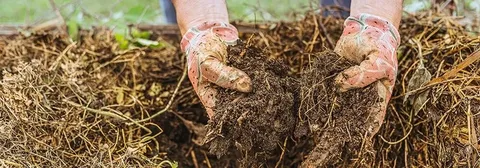The Benefits of Composting and How to Get Started
Composting is a sustainable way to recycle organic waste, improve soil health, and reduce your carbon footprint. Whether you have a small garden or a large backyard, composting is a simple and rewarding practice that can benefit both your plants and the environment. In this guide, we’ll explore the many benefits of composting and provide you with the essential steps to start your own composting system at home.
What is Composting?
Composting is the natural process of breaking down organic materials, such as food scraps, leaves, and yard waste, into nutrient-rich humus or compost. This process is carried out by microorganisms, fungi, and bacteria that decompose the organic matter over time. The resulting compost can be used to enrich the soil in your garden, making it healthier and more productive.
Benefits of Composting

1. Reduces Landfill Waste
Composting helps reduce the amount of organic waste that ends up in landfills. When food scraps and yard waste are sent to landfills, they produce methane, a potent greenhouse gas. By composting, you can divert these materials from the landfill and reduce your carbon footprint.
2. Improves Soil Quality
Compost is rich in essential nutrients, including nitrogen, phosphorus, and potassium. When added to soil, it improves soil structure, water retention, and drainage. Compost also enhances the soil’s ability to support healthy plant growth, making it an excellent addition to garden beds and lawns.
3. Reduces the Need for Chemical Fertilizers
Using compost in your garden reduces the need for chemical fertilizers. Compost naturally adds nutrients to the soil, which promotes plant growth and reduces the reliance on synthetic fertilizers that can harm the environment.
4. Enriches Plant Growth
Compost provides plants with a slow-release source of nutrients, which helps them grow stronger and healthier. Plants grown in compost-enriched soil have better root development and improved resistance to pests and diseases.
5. Saves Money
Composting can save you money on fertilizers, soil amendments, and waste disposal. By turning organic waste into nutrient-rich compost, you can reduce the need to buy commercial soil products and save on waste collection fees.
6. Helps Conserve Water
Compost improves soil’s water retention capacity, reducing the need for frequent watering. This is particularly helpful during dry spells or in regions with water scarcity.
How to Start Composting at Home
Starting a compost pile is simple and requires minimal materials. Here’s how to get started:
1. Choose a Composting Method
There are several ways to compost at home, depending on your space, time, and needs:
- Traditional Compost Pile: If you have a large backyard, you can create a compost pile in a corner of your garden. This is a simple and low-maintenance option.
- Compost Bin: A compost bin is a contained system that helps keep composting materials organized and more efficient. These bins come in various sizes and can be placed in a corner of your yard or on a balcony.
- Vermicomposting (Worm Composting): For small spaces, vermicomposting uses worms to break down organic matter. You can set up a worm bin indoors or on a balcony.
- Tumbler Composter: A tumbler composter is a rotating drum that speeds up the composting process. It’s ideal for those who want a faster turnaround time and are willing to put in a bit more effort.
2. Select a Location
Choose a location for your compost bin or pile that is convenient and has good airflow. Ideally, it should be in a shaded area to prevent it from drying out too quickly, but still accessible for adding materials and turning the pile.
3. Gather Composting Materials
The key to successful composting is balancing “green” (nitrogen-rich) materials and “brown” (carbon-rich) materials. A good compost pile should contain a mix of both to allow for proper decomposition.
Green Materials (Nitrogen-rich):
- Fruit and vegetable scraps
- Coffee grounds
- Grass clippings
- Manure (from herbivores)
- Green leaves
Brown Materials (Carbon-rich):
- Dry leaves
- Straw or hay
- Wood chips or sawdust
- Shredded newspaper or cardboard
- Eggshells
4. Start Layering the Materials
Begin by placing a layer of coarse materials (like twigs or straw) at the bottom of your compost pile to allow for airflow. Then, alternate between layers of green and brown materials, ensuring that each layer is not too thick.
5. Maintain the Pile
To speed up the decomposition process, turn the compost pile every few weeks with a pitchfork or shovel. This aerates the pile and helps prevent odors. If the pile is too dry, add water to keep it moist, but not soaking.
6. Harvest the Compost
After several months (typically 3-6 months), the compost will be dark, crumbly, and have an earthy smell. This means it’s ready to use. If you’re using a compost bin, you can simply remove the finished compost from the bottom.
Composting Tips and Tricks

- Avoid Composting Meat, Dairy, and Oily Foods: These materials can attract pests and slow down the decomposition process.
- Shred Larger Materials: Shredding larger items like branches or cardboard helps them break down more quickly.
- Monitor Moisture Levels: The compost pile should be moist, like a damp sponge. Too much water can cause it to rot, while too little can slow down decomposition.
- Use a Compost Thermometer: A compost thermometer can help you monitor the internal temperature of your pile. The ideal temperature for composting is between 130°F and 160°F (54°C and 71°C).
Final Thoughts
Composting is a simple and effective way to create nutrient-rich soil, reduce waste, and contribute to a more sustainable lifestyle. By following the basic steps outlined above, you can start composting at home and reap the many benefits it offers. Whether you have a small apartment or a large garden, composting is a rewarding activity that’s good for your plants, your wallet, and the planet.
